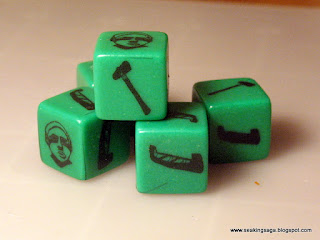Open Combat by Carl Brown is a new miniature rule system released through his website and company Second Thunder. Having heard about the game from a couple of my favorite podcasts, Meeples and Miniatures and Fool's Daily, I decided to pick it up. On the face of it, the game system is flexible for ancient, medieval or fantasy gaming with a limited number of models per side. It is easily customized to fit any miniature, and it promises to be quick to set up and quick to play.
What is perhaps the most unique aspect of the game, one that sets it apart from other miniature wargames, is the creation of your army list or warband. Warbands are based on a point system ("renown") and can be set at various levels for desired length of play and size of the warband. One hundred points will get you a small force with some average to good characteristics. Points are assigned to each individual model for five basic statistics - Speed, Attack, Defense, Fortitude and Mind. Weapons and special abilities (Aim, Inspiration, etc.) add points as well.
The mechanic for combat is based on adding up modifiers to the character's attack value, such as cover, high ground and so forth. The number of points greater than the defender's total (if any) determines the amount of dice the attacker rolls, with a maximum of three. The attacker takes the best value, and this should give him a greater chance of scoring a hit. There is no save roll if a model is hit, this is built into the modifiers and the fortitude (i.e. "hit points"). This makes for a quick resolution of combat.
Initially, I was a bit perplexed by the lack of lists or standards? What is the typical defense value for a Viking in chain mail? What sort of attack would a Roman legionnaire have? And, if we're getting into fantasy, what about a goblin, an orc or a werewolf?
Lest you think the lack of lists can be attributed to the authoer's laziness or inattentiveness, it was purely intentional and it may be the key selling point of the game. In a true skirmish game, each miniature is an individual and all individuals are distinct. Not all Vikings were equally tough. A quick but naked Celt could have a defense of 6 and a clumsy Roman in armor might have a defense of 3 if you so choose. This gives you the freedom to create a warband with a few powerful heroes or a swarming mob, or somewhere in between. You could even create a warband made of a single god-like character (25 attack! 25 defense!) but the rules system naturally limits such pointless overpowering. No matter how high your attack, you still roll only three dice and pick the best, and no matter how high you defense, your opponent still gets to roll a single die. Regular players of the game should find an equilibrium based on their style of play.
For my initial game, I decided to test out character creation and put some Skraelings up against Vikings. The Skraelings were initially for SAGA, but I never had a great desire to play their battleboard. Loved the figures, so now I can play the Indians as I envisioned them. The Vikings were led by an 11 year old son of a friend, a Boy Scout with an deep interest in history - definitely a future war gamer.
The Indians are low on defense and fortitude, but I spent points on Speed, Aim and Nimbleness. Run and Gun!
Above, the Vikings advance to the tree line.
Initiative is the usual IGYG system, but rolling a "1" during combat ends your turn. The does bear some similarities to the Song of Blades and Heroes iterations, in that a poor roll ends your turn before all the models have moved.
Position matters in Open Combat. This Viking about to get shot in the back will only be able to apply half of his Defense value.
another Brave activates and takes him out.
With their Jarl slain, the Vikings reach the breaking point on their renown, and the game is called in favor of the Skraelings. Total game time is under an hour, not bad for two players, one completely new to miniature wargaming.
Open Combat definitely fills a niche in my gaming habit. The DIY nature of warband construction allows me to field some figures and forces the way I think they should be played, all within a balanced game mechanic. It is quick to learn, and quick to teach, but not at all oversimplified.
Currently, it is only available as a PDF from his website, though a published edition may be down the road if the game catches on. I hope it is because Carl Brown is very supportive of his product through forums and outreach.
Update: Apologies to Carl BROWN for originally listing his name as Brand. Not sure who I can blame for that, but if I find the culprit I'll be sure to identify him!






































